Does anyone here know what material exactly is used for pressing tweeter and midrange soft-domes?I assume it to be some thermoplast, such as nylon like material, but time and again silk is referred to..
And then, where to source that material?
And then, where to source that material?
Depends, there are plastic ( polypropylene or whatever) textile domes, silk domes ( actually silk treated ) aluminium, titanium, etc.
I have done some tweeters from actual silk ( bought from shop for clothes material, sewing materials, etc. ).
Tested with wood glue , actually it is flexible and sounded good.
I have done some tweeters from actual silk ( bought from shop for clothes material, sewing materials, etc. ).
Tested with wood glue , actually it is flexible and sounded good.
Maybe I should have been more specific: I was referring to typical cloth soft domes. I am familiar with vaccuum-forming of the various poly- and other sheet materials.
I assume you have used some form of heating and form-pressing of the silk sheets?
I assume you have used some form of heating and form-pressing of the silk sheets?
I have used some plastic dome I had laying around and made a press " form " out of cement from that plastic dome, used oil, silk with wood glue, pressed with some weight on it. Mine were 2.5 inch or so mid- high drivers
I also tried directly on the plastic with oil again, and wood glue on the silk , tighten on the back with some zip ties, worked just fine.
You can find fine silk for window curtains . Thats what I used.
Some light bulbs have " usable " domes made of plastic , to be used as a matrix.
I also tried directly on the plastic with oil again, and wood glue on the silk , tighten on the back with some zip ties, worked just fine.
You can find fine silk for window curtains . Thats what I used.
Some light bulbs have " usable " domes made of plastic , to be used as a matrix.
Attachments
Hello Bruno,
Thanx for the pictures and the answers. Are you sure the material in picture 2 is silk, not nylon?
Thanx for the pictures and the answers. Are you sure the material in picture 2 is silk, not nylon?
The one in the picture I'm not sure 100% , might be silk with something else, or just silk. ( doesn't feel like nylon , but hey I might be wrong. )
I have used silk 100% and also the material from that picture. ( it sounded good as it's thin, not so dense, with wood glue it looked / ended up very similar to what silk dome tweeters feel like on touch, flexibility. For me the surround was harder to make, I tried some EVA Foam ( youtube with great results even for woofers ) but porbably not the right composition, concetration. Used surround from other speakers, 2.5", you can get them new anyway .
I have changed the cone on some regular 3inch speakers with ones I made from this material, and there was improvement in the clarity, voice/ highs, but I don;t have the necessary tools, equipement to test , fully make great diy speakers, I mostly did it for fun, I don't know what you try to achive.
- Bruno.
I have used silk 100% and also the material from that picture. ( it sounded good as it's thin, not so dense, with wood glue it looked / ended up very similar to what silk dome tweeters feel like on touch, flexibility. For me the surround was harder to make, I tried some EVA Foam ( youtube with great results even for woofers ) but porbably not the right composition, concetration. Used surround from other speakers, 2.5", you can get them new anyway .
I have changed the cone on some regular 3inch speakers with ones I made from this material, and there was improvement in the clarity, voice/ highs, but I don;t have the necessary tools, equipement to test , fully make great diy speakers, I mostly did it for fun, I don't know what you try to achive.
- Bruno.
Silk alone will not keep its dome shape, all textiles need impregnation in some kind of resin which is later cured under heat and pressure in a set of male-female dies.
A lot of Phenolic resin and cotton fiber thick-ish cloth will give you old style brown hard domes, still much used in cheap horn drivers, not sure anybody still makes tweeters out of it; silk is about same but uses very thin cloth and as little resin as possible, it is still flexible.
A lot of Phenolic resin and cotton fiber thick-ish cloth will give you old style brown hard domes, still much used in cheap horn drivers, not sure anybody still makes tweeters out of it; silk is about same but uses very thin cloth and as little resin as possible, it is still flexible.
The thing I cannot get my head around is how it is possible to form large dome structures (65-75mm) from non-thermoplasts such as silk: one would assume this would result in a very wrinkled dome.
I am well aware of the coating part and the role it plays, although the air-sealing function has not been mentioned yet.
As I understand from the dome Mid thread, the ATC Dr. Kurt Muller 75 mm domes are yellow-ish before coating.cotton fiber thick-ish cloth will give you old style brown hard domes
I am well aware of the coating part and the role it plays, although the air-sealing function has not been mentioned yet.
Microfiber cloth ( maybe a bit thick for tweeters , but works for mid range ) .
I'll try making some later , can not find the ones I did before.
I'll try making some later , can not find the ones I did before.
Attachments
-
 20240220_100205.jpg156.7 KB · Views: 61
20240220_100205.jpg156.7 KB · Views: 61 -
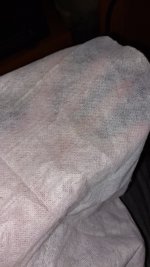 20240220_100139.jpg495 KB · Views: 68
20240220_100139.jpg495 KB · Views: 68 -
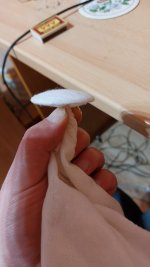 20240220_100310.jpg201.3 KB · Views: 65
20240220_100310.jpg201.3 KB · Views: 65 -
 20240220_100309.jpg161.2 KB · Views: 56
20240220_100309.jpg161.2 KB · Views: 56 -
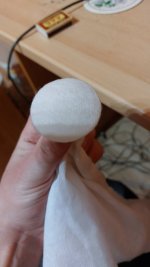 20240220_100307.jpg202.5 KB · Views: 63
20240220_100307.jpg202.5 KB · Views: 63 -
 20240220_100252.jpg171.2 KB · Views: 54
20240220_100252.jpg171.2 KB · Views: 54 -
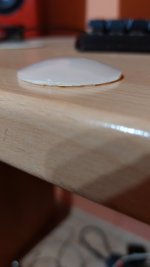 20240220_100205.jpg156.7 KB · Views: 54
20240220_100205.jpg156.7 KB · Views: 54 -
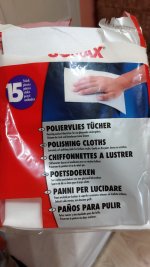 20240220_100829.jpg305.5 KB · Views: 58
20240220_100829.jpg305.5 KB · Views: 58 -
 20240220_100832.jpg326.5 KB · Views: 56
20240220_100832.jpg326.5 KB · Views: 56
Textile Industry is incredibly advanced and offers a huge range of products.
Not sure where you live but here in Buenos Aires and certainly in any large City worldwide there is a "textile/cloth" area where you have all kinds of it.

Just walk around, look at and touch everything 😄
You will be surprised at the huge selection and you will certainly find some dome suitable type.
Cloth is cheap so you can get many samples to test.
From 4:46 to 5:30 they show the spider pressing and cooking process, basically same thing as for domes:
Not sure where you live but here in Buenos Aires and certainly in any large City worldwide there is a "textile/cloth" area where you have all kinds of it.
Just walk around, look at and touch everything 😄
You will be surprised at the huge selection and you will certainly find some dome suitable type.
Cloth is cheap so you can get many samples to test.
From 4:46 to 5:30 they show the spider pressing and cooking process, basically same thing as for domes:
Press tools in mass-manufacturing of fabric domes and cones often exploit springs that control the speed at which the material is drawn into the press - and therefore the amount of stretching of the material that occurs. With some fine adjustment of the spring tension (which is not useful in mass-manufacturing), one can deliberately engineer radial-like ripples that can aid the final diaphragm stiffness. However, this will likely compromise the dome-former bond, and given the tolerances involved, you would probably have a lot of rejected domes too.The thing I cannot get my head around is how it is possible to form large dome structures (65-75mm) from non-thermoplasts such as silk: one would assume this would result in a very wrinkled dome.
I once 'made' aluminium dome from bottom of the beer can. Great for dust cap.
The spider making process I am familiar with, but what would be a reasonable forming temperature for open weave cotton cloth?
I bet the impregnating resin datasheet will offer proper curing temperature.
Never used phenolic resin, most popular in the speaker industry and which was used in the video above but for an analogy, I use Epoxy to hold wire to former in own made voice coils and later to assemble the whole speaker, and datasheet carries curing/hardening suggestions, from 12/16 hours at room temperature to , say, 3 Hours at 45C to 3 minutes at 100C to 30 seconds at 120C
I am certain phenolic resin suggests some time-temperature pairs too.
Impregnating resin might also be thermoplastic, like most "common" plastic materials, the dome itself is not expected to become hot.
Voice coil former on the contrary needs to be thermostable.
Dome cloth may wrinkle or stretch but since it gets pressed between mirror polished make-female dies it will take their shape.
Die separation is cloth thickness so no space for wrinkles.
If reinforcing ribs are present, they were certainly machined into the die face.
EDIT:
just found one example:

Never used phenolic resin, most popular in the speaker industry and which was used in the video above but for an analogy, I use Epoxy to hold wire to former in own made voice coils and later to assemble the whole speaker, and datasheet carries curing/hardening suggestions, from 12/16 hours at room temperature to , say, 3 Hours at 45C to 3 minutes at 100C to 30 seconds at 120C
I am certain phenolic resin suggests some time-temperature pairs too.
Impregnating resin might also be thermoplastic, like most "common" plastic materials, the dome itself is not expected to become hot.
Voice coil former on the contrary needs to be thermostable.
Dome cloth may wrinkle or stretch but since it gets pressed between mirror polished make-female dies it will take their shape.
Die separation is cloth thickness so no space for wrinkles.
If reinforcing ribs are present, they were certainly machined into the die face.
EDIT:
just found one example:
Last edited:
That's not strictly true... ATC's 6.5" bass-mid fabric cone driver (that was effectively an extension of the 75mm dome), originally relied on the tension setting to provide adequate cone edge stiffness, sometimes with the ripples being clearly visible. Some later generations featured a less effective plastic coated edge treatment instead. No ribs were evident in the dies.Dome cloth may wrinkle or stretch but since it gets pressed between mirror polished make-female dies it will take their shape.
Die separation is cloth thickness so no space for wrinkles.
If reinforcing ribs are present, they were certainly machined into the die face.
Last edited:
- Home
- Design & Build
- Parts
- Material for pressing domes


